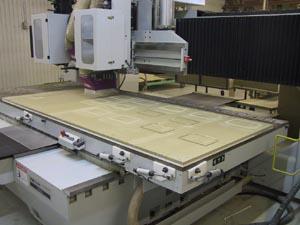Furniture manufacturers are becoming increasingly aware of the potential material savings driven by mixing parts of multiple units or orders on the same nest. Traditional nesting software is used to create nests for a given, typically pre-set, quantity of product units.
So even the most efficient nesting algorithm delivers a nest that was prepared prior to receipt of other orders and quantities, resulting in a production plan that is not necessarily optimal in terms of actual requirements.
To illustrate this process using a real example, a Plataine customer in the upholstery industry had to produce an order of 50 units, with the fabric cut in multiple layers.
First, the manufacturer generated in advance a few nesting options for various unit quantities. Such a process of evaluating multiple solutions is time consuming and not always practical in a real production environments. Moreover, in most cases only one or two options are prepared and evaluated.
Table 1 demonstrates six optional solutions of the nests’ length for different quantities of 'sets per layer', according to manufacturing constraints. In this case, nesting five sets per layer provided the shortest nest of 1.94 meter per set.
But is this really the optimal solution for quantity of 50 sets? Is material the only factor to consider when calculating the total production cost?
When looking for the optimal solution, labor is another factor to consider as spreading time, cutting time and sorting time are also affected by the number of sets mixed. As shown in Table 2, nesting 1 set per layer drives the optimal solution in terms of labor costs, with a minimum total labor time of 0.98 hours.
In such a case, what will be the most optimal low cost decision? Should the manufacturer save material by mixing five sets per nest or save labor costs by mixing one set per nest?
The solution
The correct approach for solving such a dilemma is to calculate the total cost, considering both labor and material cost. Let's assume a labor cost of $15 per hour and material costs of $4 per meter and review the results in Table 3.
Table 3 shows that cutting two sets per layer and five sets per layer will result in an optimal solution with a total cost of around $415 for cutting 50 units.
In this case, where both two sets per layer and five sets per layer show an optimal result, one will choose two sets per layer as the optimal solution because there is less labor.
This solution is relevant for the given order of 50 sets. Once the quantity changes, the optimal solution needs to be calculated again.
Summary
In real production environments, where hundreds of parts for dozens of products need to be delivered on time, manual or semi-automatic nesting tools are just not good enough as they require precious time and hardly find the true optimal solution.
Nesting software may be partly useful in finding the local optimum of material utilization. However, since it is disconnected from complete order information, inventory and production constraints, it misses the opportunity of total production cost optimization.
Production optimization software offers true, real-time optimization by balancing multiple (often conflicting) optimization goals (e.g. material utilization, machine throughput, bundling/sorting costs and more).
It automatically considers all production process factors at once: customer orders from the ERP, available materials from the inventory system and product design from the CAD system, to generate a complete, ready to cut, optimal production plan for any given order quantity.
Production optimization software optimally, dynamically and automatically decides in each case, what is the best mixing option to achieve minimum production cost based on configurable customer's production rules, machine constraints and management guidance.
For additional information please contact: [email protected].






Have something to say? Share your thoughts with us in the comments below.